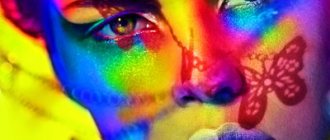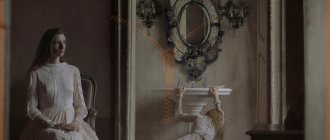Almost every person knows or has heard about the Rorschach test. Some even encountered its passage. What kind of test is this actually? It turns out that this is a fairly powerful tool in the hands of an intelligent psychologist, used to diagnose a person’s personality.
Swiss psychiatrist and psychologist (1884-1922), author of the Rorschach Blot personality test. Coined the term “psychodiagnostics”
Initially, Hermann Rorschach created 40 cards with various blots, but they turned out to be extremely difficult to print. Not a single printing house took on this. And not at all because his ideas were anti-scientific or some kind of fantastic, but simply there was no technical possibility to print these intricate blots on one sheet of paper in a convenient format. First, the number of test spots was reduced to 15, and then to 10. And only after that they were published by one publishing house.
Rorschach published a book in which he described how his test worked. He believed that human behavior depends on all factors, both surrounding the person and filling him from the inside (extraversion and introversion). Testing with ink blots allows one to estimate the relationship between these inversions. This tool makes it possible to weigh their “relationships”, determine personality deviations and its strengths.
Spot 1
The first spot opens the test and shows how a person perceives new information. Here you can see how the test subject is able to work on previously unfamiliar tasks. That is, how he knows how to cope with stress. Most people see it as the face of a large animal, a moth (butterfly) or a bat. For example, the image of a bat can mean fear or the birth of something new. The butterfly means rebirth, the ability to improve, grow and develop. The muzzle of a large animal is a symbol of struggle and fear of impending circumstances.
Card 6
Most people notice sexual imagery when they look at this inkblot.
Psychologists say that if you do not see either female or male organs in the spot, you are probably experiencing problems in your personal and sexual life.
If you see a mountain , this indicates a feeling of anxiety and that you perceive life as an endless hard struggle.
Spot 2
The second red and black spot often has sexual associations or makes you see something related to blood. This spot illustrates how capable a person is of managing his negative emotions: anger, rage, short temper, etc. For example, if you see an image of something related to sex or a couple, then this indicates dependence on other people or sexual preoccupation. Something related to blood or other negative things - a person is very closed, he needs to fight internal fears.
Picture No. 2: two people
This drawing in the Rorschach test is most often perceived by test takers as sexual. And many people consider red elements to look like blood stains. Answers to this test can provide insight into the methods used to control pain, anger or feelings. Most people see these spots as a four-legged animal, a person looking at himself in the mirror, or two people.
- Two figures speak of an obsession with sex, an obsession with relationships.
- The dog symbolizes a faithful and devoted friend. If the test taker saw something negative in this card, then this may indicate the need to realize their own feelings or fears.
- A person looking at himself in the mirror speaks of narcissism or egocentrism of the person being tested. Depending on a person's feelings, this can be either a positive or negative trait.
- Elephant - symbolizes intelligence and memory, deep thinking, but it can also speak of negative physical self-perception.
- Bear - symbolizes aggression, independence, competition, but can also speak of vulnerability and insecurity.
- A person praying - this can symbolize attitudes towards sex from a religious point of view. Blood may mean that the person being tested associates physical pain with religion, as well as experiencing difficult emotions.
Spot 4
This image is often called the "father spot" or "paternal spot". It evokes associations with something masculine, some strong and older image. The image is large, black, blurry, sometimes scary. This spot will show authority or lack thereof, attitude towards them and details of parenting. If the test taker sees a scary monster in this blot, then this clearly indicates his complexes, immaturity, immaturity, and fear of powerful and strong people. If the skin of an animal is seen, then this indicates a lack of proper upbringing or discomfort in communicating with the father.
Decoding
Each test card has an ink blot on it. The subject, looking at Rorschach pictures, uses his imagination to recreate in his head an animated or inanimate object. Sometimes Rorschach's ink picture evokes emotions in the subject. There are times when a person uses not the entire spot, but part of it. All this must be reported to a specialist. Depending on what the subject saw, a “portrait” of the individual is compiled. You can take this test yourself, using ready-made answer options, as in entertaining psychological tests.
Article on the topic: Low blood pressure during early pregnancy - causes and signs, diagnosis, treatment methods
First card
The first Rorschach picture shows a blot of black ink. From the perception of white and black spots, the general psychotype of a healthy subject is determined. The first picture also means the state of the person with whom he came to the Rorschach inkblot test: fear, excitement, etc. Here are several answer options and their explanation:
- Mol. A person feels unnecessary to society, he is downtrodden and not sociable, and is often in a state of depression.
- Bat. Discomfort within oneself or, on the contrary, a tendency to navigate in the “dark”.
- Butterfly. Symbolizes the stage of rebirth, new beginnings.
- The animal, including its face. May mean struggling with real problems. Feeling of discomfort.
Second
The following picture is in black and red. With its help, you can determine a person's sexuality or understand his ability to control strong emotions, such as anger or rage . Often respondents see blood, people in prayer, or a long animal. Basic answers and their explanation:
- Two people. It means that in life the subject pays great attention to sex and any close relationships.
- The man in the mirror. Self-admiration, not without self-criticism.
- Dog. The subject values and values friendship and will always “lender a shoulder” and come to the rescue.
- Bear. The respondent strives for leadership and tries to express his superiority through aggression.
- Negative feelings. A person must face his problems and not run from them.
Third
This Rorschach painting features red and black ink blots. Interpretation is a person’s attitude to society. In this blot, people often see two people, a dog, a moth:
- Two people against each other. If the characters in the picture are playing a game, this stands for rivalry. People wash their hands - a feeling of “dirty”, insecurity. People eating - active communication, a wide circle of friends and acquaintances.
- Man looking in the mirror. This means inattention to people, egocentrism, and inability to understand people.
Fourth
This black and white blurry picture on the Rorschach card is called "the father's". With its help, the respondent’s reaction to authority, leadership qualities, and upbringing is determined. In a blot, people see the skin of an animal, a monster, something big and menacing:
- Monster, monster, big animal. Deciphered as recognition of authority, power, feeling of inferiority, weakness. Respect for the father and recognition of him as the main one.
- Animal skin. The subject suffers from internal dissonance when touching on the father's topic. However, this may mean, on the contrary, not perceiving one’s own attitude towards the topic of leadership.
Fifth
At this stage of the Rorschach test, the person is asked to look at a black blot. It, like the very first image, symbolizes “I”. The answers coincide by 80-90%. In other cases, the range in answers can be perceived as a great emotional impression from cards 2, 3 and 4. During testing, respondents see a moth, a butterfly, a bat in the Rorschach picture.
Article on the topic: Antiepileptic Gabapentin - instructions for use, reviews from doctors and patients, and drug analogues
Sixth
Rorschach's sixth ink painting is a black and white blot of unusual texture. For many, it is associated with close personal relationships. That's what they call it - a sexy card. To the subjects, the image resembles the skin of an animal, a hole. This type of perception of a Rorschach blot means withdrawal from society, loneliness due to reluctance or fear of close sexual relationships.
Seventh
This black and white Rorschach blot is called a woman's or child's. Respondents associate it with women or children, the contours of their heads. If a person cannot explain what he sees in the picture, this means difficult relationships with women. Here are the main visions of the blot:
- Kiss. If a person sees two heads reaching out to each other for a kiss, then this indicates a close relationship with the mother or a desire to be loved.
- Women's heads. This perception speaks of warm feelings for the mother and for all women in general.
- Children's heads. These are good childhood memories. The desire to care for someone and be loved.
Eighth
This is the first color Rorschach card, which often causes confusion among respondents. The eighth spot consists of pink, blue, gray and orange blots. If the subject cannot describe what is depicted on it or feels discomfort, then we can say that he has problems analyzing complex emotional situations. In this spot people see a butterfly, a moth, an animal standing on four legs.
Ninth
The second colored Rorschach blot, consisting of orange, pink, green spots. The picture is very difficult to perceive, which makes it possible to assess the test subject’s ability to cope with uncertainty and formulate a clear meaning. They see in it:
- General contours of a person. Indicates that the respondent is able to quickly create order from disorganized information.
- The image of evil. Such an association indicates a need for comfort, order, and systematization. Disorder unsettles such a person.
Tenth card
This is the last picture of the test. It is colored and has the following shades: blue, yellow, pink, gray, orange. The image evokes positive feelings, but respondents sometimes find it difficult to interpret. It gives rise to the following associations:
- Crab. Attachment to people and things, tolerance.
- Lobster. This speaks of tolerance, the strength to confront problems, but at the same time it indicates a fear of harming yourself and your loved ones.
- Spider. Fear of difficult situations, fear of falling into a trap, of being caught in a “web.”
- Rabbit head. It means a cheerful disposition, love of life and a willingness to continue one’s family.
- Snake. The head of this animal is deciphered as a feeling of deception, danger. Another meaning is secret sexual fantasies and desires.
- Caterpillar. The insect's head indicates the subject's possible growth as a person.
Spot 10
The last spot is the most colorful and the most complex: in color it is similar to the eighth, and in shape - to the previous ninth. People often experience pleasant emotions when looking at this image. It can become unpleasant for those who had problems identifying the previous spot, then this will cause them discomfort. If a person sees a crab or lobster in this colored spot, then this indicates his loyalty and tolerance. When a spider is seen, a person is afraid that he will be drawn into some “dirty” and dishonest story. If the image of a snake appears, then the subject is very afraid of everything unknown.
About the author of the Rorschach test
Hermann Rorschach was born on November 8, 1884 in Zurich (Switzerland). He was the eldest son of an unsuccessful artist, forced to earn a living by giving art lessons at school. Since childhood, Herman was fascinated by color spots (in all likelihood, the result of the creative efforts of his father and the boy’s own love of painting), and his school friends nicknamed him Blob. When Herman was twelve, his mother died, and when the young man turned eighteen, his father also died. After graduating with honors from high school, Rorschach decided to study medicine. In 1912, he received his medical degree from the University of Zurich, after which he worked in a number of psychiatric hospitals. In 1911, while still studying at the university, Rorschach conducted a series of interesting experiments to test whether schoolchildren gifted with artistic talents had a more developed imagination when interpreting ordinary inkblots. This research had a huge impact not only on the future career of the scientist, but also on the development of psychology as a science in general. It must be said that Rorschach was not the first to use color spots in his research, but in his experiment they were used for the first time within the framework of an analytical approach. The results of the scientist's first experiment were lost over time, but over the next ten years Rorschach conducted large-scale research and developed a systematic technique that allows psychologists to determine people's personality types using ordinary inkblots. Thanks to his work in a psychiatric clinic, the researcher had free access to its patients. Thus, Rorschach studied both mentally ill people and emotionally healthy people, which allowed him to develop a systematic test using inkblots, which can be used to analyze a person’s personality characteristics, determine his personality type and, if necessary, correct it.
In 1921, Rorschach presented the results of his large-scale work to the world by publishing a book called Psychodiagnostics. In it, the author outlined his theory about the personal characteristics of people. One of the main points is that each person's personality consists of the qualities of introversion and extroversion—in other words, that we are motivated by both external and internal factors. According to the scientist, the inkblot test allows one to assess the relative ratio of these properties and identify any mental deviation or, on the contrary, personality strengths. The psychological scientific community paid virtually no attention to the first edition of Rorschach's book, since at that time the prevailing belief was that it was impossible to measure or test what a person's personality consisted of. However, over time, colleagues began to understand the usefulness of the Rorschach test, and in 1922, the psychiatrist discussed the possibilities of improving his technique at a meeting of the Psychoanalytic Society. Unfortunately, on April 1, 1922, after suffering from severe abdominal pain for a week, Hermann Rorschach was admitted to the hospital with suspected appendicitis, and on April 2 he died of peritonitis. He was only thirty-seven years old and never saw the enormous success of the psychological tool he invented.
Nickname
In the last years of their studies, students were allowed to join student unions. Hermann Rorschach was enrolled in the Scafusia society. It was there that the young man received the nickname Blob. And this was no accident. At that time, the game of the same name was gaining popularity among young people. Of course, Rorschach loved her too. The blots were made as follows: ink was poured onto the paper, then the sheet was folded in half. The result was bizarre images. It is likely that it was the childhood nickname and love for this game that prompted Herman to develop psychological tests based on pictures.
There is another version of the origin of his nickname. Rorschach's favorite author was Wilhelm Busch. The artist Kleksel appeared in one of the poet’s stories. Many believed that it was in his honor that Herman received his nickname.
After finishing his studies, Klyaksa could not decide on his future profession. Herman was torn between natural sciences and art. Rorschach spoke about his dilemma in a letter to Ernst Haeckel. He advised him to study natural sciences. Given Haeckel's specialization, it would have been difficult to get any other advice. As a result, Herman chose medicine. At the age of 19 he went to study in Zurich.








